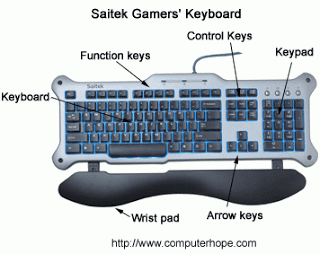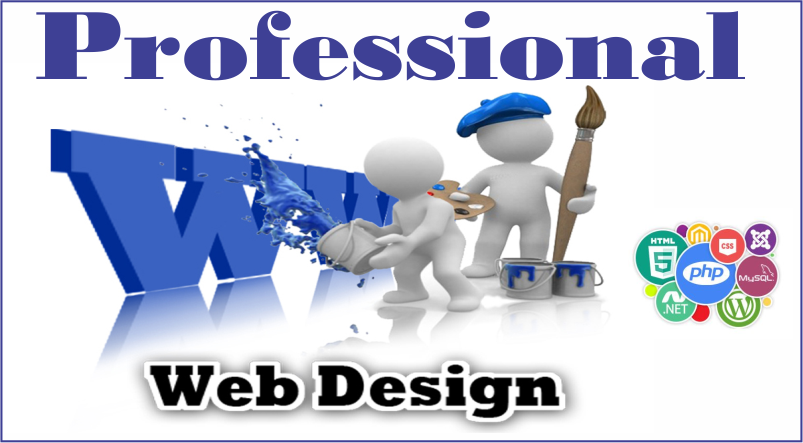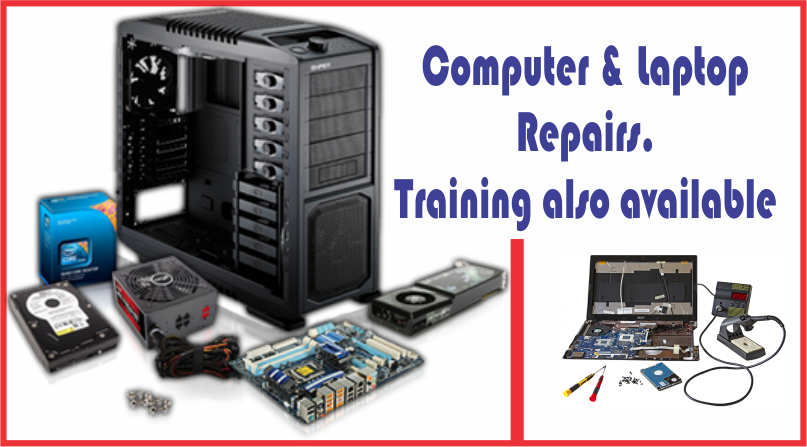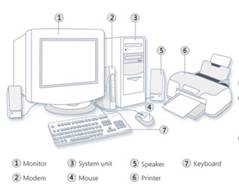Downloadable Handouts from KINGSZINO'S Computer Classes
We have created handbooks in pdf format to help our students study in their own time.
| Basic Computer Training | Internet | Handware | Word | Excel | Power Point | Publisher | |
| Download now | download now | Download now | Download now | Download now | Download now | Download now | Download now |
INTRODUCTION TO COMPUTERS
What is Computer?
A Computer is a device or set of devices that work under the control of a stored program, automatically accepts and processes data to provide information.
Automatic: it carries out instructions with minimum human intervention
Re-programmable: it stores instruction (the program)
A data processor: it carries out operations on data (numbers or words) made up of a combination of digits
to produce information.
It performs the following three operations in sequence.
1. It receives data & instructions from the input device. 2. Processes the data as per instructions.
3. Provides the result (output) in a desired form.
Data: It is the collection of raw facts, figures & symbols.
Example : Names of students and their marks in different subjects listed in random order.
Information: Information is the meaningful data that is relevant, accurate, up to date and can be used to make decisions.
Example: When the names of students are arranged in alphabetical order, total and average marks are calculated & presented in a tabular form, it is information.
Program: Set of instructions that enables a computer to perform a given task.
Advantages of computers:
1. High speed: Computers have the ability to perform routine tasks at a greater speed than human beings.
They can perform millions of calculations in seconds.
2. Accuracy: Computers are used to perform tasks in a way that ensures accuracy.
3. Storage: Computers can store large amount of information. Any item of data or any instruction stored in the memory can be retrieved by the computer at lightning speeds.
4. Automation: Computers can be instructed to perform complex tasks automatically ( which increases the productivity).
5. Diligence: Computers can perform the same task repeatedly & with the same accuracy without getting tired.
6. Versatility: Computers are flexible to perform both simple and complex tasks.
7. Cost effectiveness: Computers reduce the amount of paper work and human effort, thereby reducing costs.
Limitations of computers:
1. Computers need clear & complete instructions to perform a task accurately. If the instructions are not clear & complete, the computer will not produce the required result.
2. Computers cannot think.
3. Computers cannot learn by experience.
COMPONENT PART OF THE COMPUTER
1. keyboard: This is an input device use for sending/inputting data or information into the computer. It is very similar to the typing keys of the typewriter. It is divided into different areas as follows:-
1.1 Typing keys: It is also known as typewriter keys. This is the alphabetical area (A-Z) used or alphabetic data(s)
1.2 Numeric keys: It is used for inputting numbers.
1.3 Functional keys: These are series of keys (F1-F12) that have their usage depending on a particular application.
1.4 Cursor keys: These are keys that aid the movement of the cursor, they include arrow keys (←↑→↓), Page Up, Page Down, Home, End, Delete, Insert.
1.5 Modify keys: This includes Ctrl, Alt, Shift, they are also called because they depend on other keys to carry out their functions.
1.6 Indicator area: Keyboard also has a status indicator area. This area has three lights that display status (on or off). They are Num Lock, Scroll Lock, Cap Lock. This three keys toggle there respective mode on or off when they are pressed.
Num lock: Toggles the key of the numeric keypad between cursor movement and numeric entry.
Caps lock: toggles the letter keys between lower case and upper case.
Keyboard Indicator |
Scroll lock: Toggle between two ways of using the cursor keys.
![]()

2. system unit: it is also known as central processing unit. It refines row data into tangible form. Hence it is said to be the heart of the computer. It receives data from the keyboard and gives out data through the monitor. There are three main unseen elements involved in the performance of this duty, namely- the main memory, the arithmetic logic unit.
3. The main memory: It is also known as the internal storage devices. This holds program to be executed and the associated data. Its of two types ROM and RAM.
Rom (read only memory): can only read from, neither can the contents be tempered with. It holds information permanently.
Ram (random access memory): This section holds programmes, instruction and data being processed and stored intermediate results of processed data awaiting transfer to the output device or storage device.
3. Control units: this device is responsible for controlling and co-ordinating all other devices. The controlling and coordinating is done by encoding and decoding i.e. interpreting and implementing. It does the inputting of data, processing the data and outputting the data.
5. Arithmetic logical unit (ALU): This consist of two units, The Arithmetic Unit and Logical Unit. The Arithmetic Unit function such as addition, subtraction, multiplication, and division.
6. The logical unit: Performs logical operations such as or, not, and, e.t.c.
7. Monitor: it can also be called the visual display unit or the screen. It is an output device responsible for displaying any information after being processed. It you with the visuals of your work.
GENERATIONS OF COMPUTER
Just like human generations, computers too have been divided into different group of generations.
FIRST GENERATION (1945-59): The computers of this period where machines, which have tubes and value switching devices. They input data using a punched card and output was on paper or on a magnetic tape. It marked the beginning or programming and programming language consisting of zeros and ones (0s & 1s). They feature as low speed, low memory, high failure rate, high cost & very large size e.g. ENIAC.
SECOND GENERATION (1960-65): This computer uses transistor instead of tubes, these transistors were smaller, faster and more reliable and produced less heat. They use magnetic tape instead of punched card, for storage, input and output. It marked the beginning of the use of high level languages (FORTRAN) a specific programming language. Cobolfo business e.g. DECPDP-1 minicomputer.
THIRD GENERATION (1966-75): This marked the introduction of IBM 300 computer. Integrated circuit (IC) was used with transistors. It marked the beginning of keyboard input and visual display unit of output. The circuit board became smaller and contained more switches now known as chips. This generation witnessed rapid growth, increased processing speed, increased accuracy, low price, less heat and reduced size.
FORTH GENERATION (1975-90): It saw the arrival of microcomputers. The use of the very large scale integrated circuit (IC) was introduced, so also were the development and the use of microprocessor. Input and output devices were improved upon and many languages were developed to solve business problems. E.g. IBM, Apple, Commodore etc. it witnessed smaller CPU, faster CPU, and low cost. These marked the computer age.
FIFTH GENERATION (1990-TILL DATE): The PC’s at the generation are being developed in Japan, USA and Europe; they are expected to process knowledge rather than data. With the arrival of Pentium and its advancement, the signs for future PC are rather being felt. They are expected to diagnose, hypothesis and make inferences, great improvement in computer technology, improves speed and storage capacities.
TYPES OF COMPUTERS
1) DIGITAL COMPUTER: These are computers that understand the string of 0 & 1 digital are commonly in business environment i.e. bank.
2) ANALOGUE COMPUTER: These are machines that are used for data collection and they are base on analogue signal. Use for war, games, to focus weather.
3) HYBRID COMPUTER: It has the function of both the analogue and the digital computer e.g. house manager.
CLASSES OF COMPUTER
There are four classes of computer which include:-
a) Micro Computer.
b) Mini Computer.
c) Mainframe Computer
d) Super Computer
a) MICRO COMPUTER: this is the forth generations of PC’s, manufactured in the 70s. they are smaller and cheaper (meaning smaller in size). They are also referred to as PC (personal computer) or work station. The liked of the PC’s are laptop, palmtop, hand held/pocket size pc.
b) MINI COMPUTER: It is physically larger than the micro computer, it was develop for the use of the military and was used before the arrival of the micro computers. Today, mini PC’s are being used in an organization where large amount of data are processed, they can serve a number ranging up to 40,000 users. It is very expensive most modern armies have mini computers which are used on the battle field to process large amount of data’s received from satellite e.g. Hp1000, DG900, PDP11 and PD8-/E.
c) MAINFRAME COMPUTERS: It processes vast amount of datas. IBM is a major supplier. They are very large and have to be housed in a special room whose temperature and humidity are low. It is very expensive and is avoidable mostly by multinational companies and government parastatal. It processes a very large amount data in seconds and respond to thousand of users simultaneously.
d) SUPER COMPUTERS: It processes large gigantic data in the quickest possible time and very expensive to buy. They are commonly used by spaces center worldwide.
COMPUTERIZATION
Computerization is the act of working with a computer system. There are three elements that are involved. We have the hardware, software and peoples ware. These elements compliment each other.
HARDWARE
This is the physical element of the computer. They are physical because we can see and touch them. they are divided into input device, output device, and storage device.
- INPUT DEVICE: this is the means by which data are sent into the computer through the keyboard, mouse, joy stick e.t.c. therefore, before data can be processed it must be read from an output and then store in the main memory of the computer. This data must be properly supplied to give tangible results, Hence in computer language we say garbage in garbage out (GIGO).
SOME TYPES OF INPUT DEVICES
a) MOUSE: this is the most recent development it’s the type of input devices that allows the user to move the cursor on the screen to perform a specific function by moving the “Hand Hold Device” on a flat surface called the mat mouse, it is attached to the computer by a cable that transmit’s movement over a flat surface.
The mouse has a bottom that can be clicked to signal the computer in which the selection be pointed to. The process of pressing down the mouse is called “clicking”. This can be done in three ways Right Clicking, Left Clicking, Double Clicking.
b) WORKLATE: it is also known as digitizer pad, it is attached to the computer through a cable. The work slate is sensitized and when the user draws on it, the image also appears on the display unit. It is basically used for graphic designing.
c) SCANNER: It is a machine use for transferring pictures, images, etc into the computer. When an image or picture is scanned it appears to the display unit exactly as it is.
d) JOYSTICK: This is another input device used for playing games. When connected to the system unit, it can be used to play all kind of games
e) LIGHT PEN: This is inform of a pen and can be used on the screen, whenever you write or draw on the display screen, it appears inside, it has a cable connected to the system unit.
f) KEYBOARD: It is also an input device. (read detail, in component of system unit)
2. OUTPUT DEVICE: The Output of a computer system depends on the users name and application. Computer users are confronted with all kind of assorted computer output systems which range from graphic design, text etc.
SOME TYPES OF OUTPUT DEVICE.
a) DISPLAY UNITS: It is also called monitor. It is used for displaying the data inputted. A well designed screen is adjustable so that it can be lifted and swived for convenience purposes. Some screens are single coloured(monochrome), and others in colour forms (VGA adapters), SVGA, etc. it is of various sizes ranging from 12 inches, 14 inches, 17 inches, 21 inches, 24 inches etc. As data’s are entered from the keyboard each characters are displayed on the screen which allows the user to make immediate correction.
b) PRINTER: This produces hard copy of an information on a paper, unlike the monitor that produces a soft copy. The printer differs base on size and use to produce variety’s of work. Some are commonly known printers are dos matrix, Desk jet, LaserJet, Line printer. Etc.
DOS MATRIX PRINTER: It is a printer which printing quality is in dot. It is noisy and spends much time in printing e.g. Epson LQ & FX printers.
LINE PRINTERS: It prints out in line on the paper e.g. HP Deskjet, HP Officejet.
MIN HEAVY DUTY: it prints out in full page or job at a time. It prints in 3 seconds e.g. HP Laserjet 4M plus, Canno Laser 1100, etc.
3. STORAGE DEVICE: Apart from the main memory we also have we also have an auxiliary storage device that act as a backup. That is , it assist the main memory in storing information that are not presently required. i.e. disks, video cd’s, etc they can store information for a very long period time.
a) DISK: They are used for recording with the micro computers. The amount of information they can hold depends on the sizes, density or type. i.e. floppy disk, CD, Hard Disk.
i. FLOPPY DISK: It is a round magnetically coated plastic disk inside a protective jacket. They are two sizes 5.25 or 3.5 inches and have different storage capacity’s. the 5.25 inches floppy disk is inside a hard plastic case.
ii COMPACT DISK (CD): A non magnetic optional disk used range amount of information. A CD can store 600mb of information, equivalent to over 1700 double density floppy disk.
iii HARD DISK: This referred to the hard disk drive that stores data/information and not the part that records or reads from it.
SOFTWARE
They are set of computer programmes that operates and perform specific task. This programmes are detailed step by step instruction that tells a computer how to carry out a specific task. They are written in programming languages such as basic, Pascal, etc. It is usually distributed in one or more diskettes. There are two types of software which are.
- Operating System: This manages most of your computer activities including the allocation of computer resources, maintenance of files and running of application software. As a resource manager, the operating system (OS) controls the flows of information through the computer. E.g. data accepting by the keyboard, seen on the display or sent to the printer is under the control of the operating system. As file manager the operating system is sued to name, save, retrieve, and maintain the program and data file you create on the computer. (a file is a collection of related records e.g. letter).
It is also a vital link between the computer hardware and the application software. There are various types of operating system e.g. Ms DOS, Windows, Novel, Unit, Macintosh etc. (note: Novel and Unit are basically network programmes).
- Application Software: It is designed to help accomplish a certain type of task like typing letters, calculating, designing, etc. example are Word Processing, Database Management, and Spreadsheet.
PEOPLE WARE
This refers to the interface between the hardware and the software. Basically, those operating the computer are known as people ware. They complete the computerizing system. A computer might be ready with its software, someone need to operate it. The computer world recognizes these three independent parts before it is fully put to use. Although much have not been said about the people ware.
USES OF COMPUTER
The main reasons why organization and individual decide to use computers are as follows:-
- Computers are very faster in carrying out it operations.
- Computers has very large capacity, where large numbers of data can be stored in its memory for future reference.
- The overall cost for computerization is very low compared to manual processing cost. i.e. consider a company with 10,000 employee, computer makes it easy to reach them on time.
- It assist in decision making, that is , it delivers information in timely manner. E.g. employing, recruitment, promotion etc.
- It accommodates growth, that is, computer enables some organization to move forward thereby compete with other firms.
- computer improves overall qualities of life, that is, it assist in improving various forms of life. E.g games etc.
VIRUS AND ANTIVIRUS
Virus can be defined as a piece of rebellious software which puts itself inside another programme and duplicate itself by spreading from memory to storage and even into diskette. This affect the well functioning of other programs and the program may become malfunctions or inaccessible. They produce variety of symptoms in the system. Some even multiply without much change. They can damage files and hard disk. There are various types of virus which include file infector and Trojan horse.
- File Infector: A file infector virus adds code to the file that runs program. When the program is running the virus spread to other program. This virus is very effective and can damage files and program e.g. anti com viruses. This set of virus can oly be removed by using an antivirus programme from a clean disk.
- Trojan Horse: These are the most destructive viruses and are difficult to recognize once they infected file or disk they may not be removed again. One thing about this virus is that they are distinguished as legitimate programs.
HOW TO PREVENT AGAINST VIRUS
Virus can be prevented through the following ways:-
- Install antivirus software’s on your system that will automatically detect virus when virus infected disk is inserted.
- Turn the system essential files to read only. Files like command.com, config.sys and auto exe.bat and programmes executable files.
- Rightly protect your disk if allowed scan it first before using it.
- When a virus is discovered stop work immediately and cleanse the virus from such disk then boot the system again.
- Make sure the computer environment is always clean and free from dust.
- Don’t eat anything that will attract insect and throw it into the computer system.
- Always be current with latest antivirus and have a copy on your computer.




